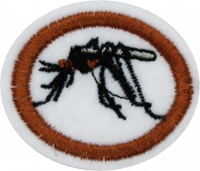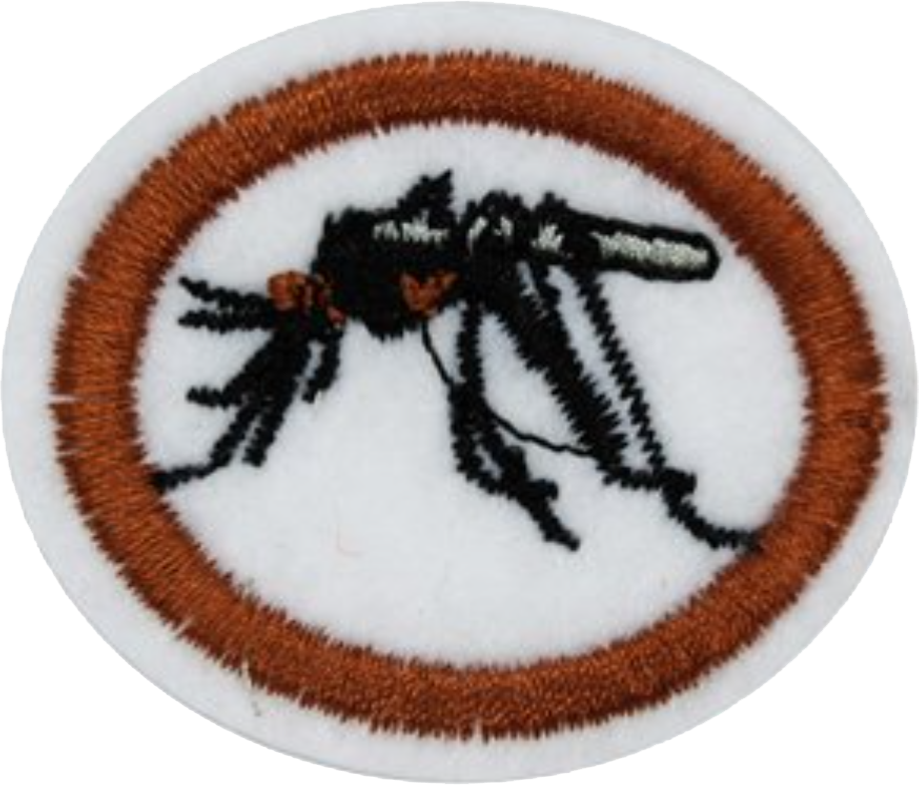Difference between revisions of "AY Honors/Harmful Animals/Answer Key/es"
(Created page with "</noinclude> <!-- 6. Escoger y presentar las siguientes características de 2 animales nocivos: --> <noinclude>") |
|||
| (16 intermediate revisions by 2 users not shown) | |||
| Line 1: | Line 1: | ||
| − | + | {{HonorSubpage}} | |
| − | |||
| − | |||
| − | |||
| − | |||
| − | |||
| − | |||
| − | |||
| − | |||
| − | |||
| − | |||
| − | |||
| − | |||
<section begin="Body" /> | <section begin="Body" /> | ||
{{ansreq|page={{#titleparts:{{PAGENAME}}|2|1}}|num=1}} | {{ansreq|page={{#titleparts:{{PAGENAME}}|2|1}}|num=1}} | ||
| Line 23: | Line 11: | ||
<!-- 2. ¿Cuál es la diferencia entre animales nocivos y animales venenosos? --> | <!-- 2. ¿Cuál es la diferencia entre animales nocivos y animales venenosos? --> | ||
| − | {{clear}} | + | {{clear}} |
<noinclude></noinclude> | <noinclude></noinclude> | ||
{{CloseReq}} <!-- 2 --> | {{CloseReq}} <!-- 2 --> | ||
{{ansreq|page={{#titleparts:{{PAGENAME}}|2|1}}|num=3}} | {{ansreq|page={{#titleparts:{{PAGENAME}}|2|1}}|num=3}} | ||
| − | <noinclude><!-- 3.Saber cómo algunos animales nocivos pueden estar directamente unidos a algunas clases de epidemias y pandemias. --> | + | <noinclude><!-- 3. Saber cómo algunos animales nocivos pueden estar directamente unidos a algunas clases de epidemias y pandemias. --> |
{{clear}} | {{clear}} | ||
| Line 40: | Line 28: | ||
{{ansreq|page={{#titleparts:{{PAGENAME}}|2|1}}|num=4}} | {{ansreq|page={{#titleparts:{{PAGENAME}}|2|1}}|num=4}} | ||
<noinclude></noinclude> | <noinclude></noinclude> | ||
| − | <!-- 4. Conocer como mínimo | + | <!-- 4. Conocer como mínimo cuatro tipos de enfermedades transmitidas por animales nocivos. --> |
{{clear}} | {{clear}} | ||
| Line 56: | Line 44: | ||
{{ansreq|page={{#titleparts:{{PAGENAME}}|2|1}}|num=6}} | {{ansreq|page={{#titleparts:{{PAGENAME}}|2|1}}|num=6}} | ||
<noinclude></noinclude> | <noinclude></noinclude> | ||
| − | <!-- 6. Escoger y presentar las siguientes características de | + | <!-- 6. Escoger y presentar las siguientes características de dos animales nocivos: --> |
<noinclude></noinclude> | <noinclude></noinclude> | ||
| Line 83: | Line 71: | ||
{{ansreq|page={{#titleparts:{{PAGENAME}}|2|1}}|num=7}} | {{ansreq|page={{#titleparts:{{PAGENAME}}|2|1}}|num=7}} | ||
<noinclude></noinclude> | <noinclude></noinclude> | ||
| − | <!-- 7. | + | <!-- 7. Citar por lo menos tres animales nocivos en cada una de las siguientes clases: --> |
<noinclude></noinclude> | <noinclude></noinclude> | ||
{{ansreq|page={{#titleparts:{{PAGENAME}}|2|1}}|num=7a}} | {{ansreq|page={{#titleparts:{{PAGENAME}}|2|1}}|num=7a}} | ||
<noinclude></noinclude> | <noinclude></noinclude> | ||
| − | {{: | + | {{:AY Honors/Species Account/Rattus rattus/es}} |
| − | {{: | + | |
| − | {{: | + | {{:AY Honors/Species Account/Canis latrans/es}} |
| + | |||
| + | {{:AY Honors/Species Account/Pagophilus groenlandicus/es}} | ||
<noinclude></noinclude> | <noinclude></noinclude> | ||
| Line 95: | Line 85: | ||
{{ansreq|page={{#titleparts:{{PAGENAME}}|2|1}}|num=7b}} <!--T:17--> | {{ansreq|page={{#titleparts:{{PAGENAME}}|2|1}}|num=7b}} <!--T:17--> | ||
<noinclude></noinclude> | <noinclude></noinclude> | ||
| − | |||
| − | |||
| − | |||
<noinclude></noinclude> | <noinclude></noinclude> | ||
{{CloseReq}} <!-- 7b --> | {{CloseReq}} <!-- 7b --> | ||
{{ansreq|page={{#titleparts:{{PAGENAME}}|2|1}}|num=7c}} <!--T:18--> | {{ansreq|page={{#titleparts:{{PAGENAME}}|2|1}}|num=7c}} <!--T:18--> | ||
| − | <noinclude>< | + | <noinclude><!-- c. Reptiles --> |
| − | {{: | + | {{:AY Honors/Species Account/Heloderma suspectum/es}} |
| − | {{: | + | {{:AY Honors/Species Account/Crocodylus_niloticus/es}} |
| − | {{: | + | {{:AY Honors/Species Account/Oxyuranus scutellatus/es}} |
| − | |||
<noinclude></noinclude> | <noinclude></noinclude> | ||
{{CloseReq}} <!-- 7c --> | {{CloseReq}} <!-- 7c --> | ||
{{ansreq|page={{#titleparts:{{PAGENAME}}|2|1}}|num=7d}} <!--T:19--> | {{ansreq|page={{#titleparts:{{PAGENAME}}|2|1}}|num=7d}} <!--T:19--> | ||
| − | <noinclude>< | + | <noinclude><!-- d. Anfibios --> |
| − | {{: | + | {{:AY Honors/Species Account/Rhinella marina/es}} |
| − | {{: | + | {{:AY Honors/Species Account/Amietophrynus regularis/es}} |
| − | |||
| − | |||
<noinclude></noinclude> | <noinclude></noinclude> | ||
| Line 122: | Line 106: | ||
{{ansreq|page={{#titleparts:{{PAGENAME}}|2|1}}|num=8}} | {{ansreq|page={{#titleparts:{{PAGENAME}}|2|1}}|num=8}} | ||
<noinclude></noinclude> | <noinclude></noinclude> | ||
| − | <!-- 8. | + | <!-- 8. Descubrir por qué algunos animales nocivos son importantes para el equilibrio del ecosistema. --> |
{{clear}} | {{clear}} | ||
| Line 132: | Line 116: | ||
{{ansreq|page={{#titleparts:{{PAGENAME}}|2|1}}|num=9}} | {{ansreq|page={{#titleparts:{{PAGENAME}}|2|1}}|num=9}} | ||
<noinclude></noinclude> | <noinclude></noinclude> | ||
| − | <!-- 9. | + | <!-- 9. Aprender 4 maneras de protegerse contra animales nocivos que son encontrados en casas o empresas. --> |
{{clear}} | {{clear}} | ||
| Line 140: | Line 124: | ||
{{ansreq|page={{#titleparts:{{PAGENAME}}|2|1}}|num=10}} | {{ansreq|page={{#titleparts:{{PAGENAME}}|2|1}}|num=10}} | ||
<noinclude></noinclude> | <noinclude></noinclude> | ||
| − | <!-- 10. | + | <!-- 10. Realizar por lo menos una de las siguientes actividades: --> |
<noinclude></noinclude> | <noinclude></noinclude> | ||
{{ansreq|page={{#titleparts:{{PAGENAME}}|2|1}}|num=10a}} | {{ansreq|page={{#titleparts:{{PAGENAME}}|2|1}}|num=10a}} | ||
| Line 158: | Line 142: | ||
{{ansreq|page={{#titleparts:{{PAGENAME}}|2|1}}|num=11}} | {{ansreq|page={{#titleparts:{{PAGENAME}}|2|1}}|num=11}} | ||
<noinclude></noinclude> | <noinclude></noinclude> | ||
| − | <!-- 11. | + | <!-- 11. Descubrir 3 animales nocivos en la Biblia. --> |
| − | |||
| − | |||
| − | |||
| − | |||
| − | |||
| − | |||
| − | |||
| − | |||
| − | |||
| − | |||
| − | |||
| − | |||
| − | |||
| − | |||
| − | |||
| − | |||
| − | |||
| − | |||
| − | |||
| − | |||
| − | |||
| − | |||
| − | |||
| − | |||
| − | |||
| − | |||
| − | |||
| − | |||
| − | |||
| − | |||
| − | |||
| − | |||
| − | |||
| − | |||
| − | |||
| − | |||
| − | |||
| − | |||
| − | |||
| Line 204: | Line 149: | ||
<noinclude></noinclude> | <noinclude></noinclude> | ||
{{CloseReq}} <!-- 11 --> | {{CloseReq}} <!-- 11 --> | ||
| − | <noinclude>==Referencias== | + | <noinclude><noinclude> |
| − | + | ==Referencias== | |
<noinclude></noinclude> | <noinclude></noinclude> | ||
| − | + | {{CloseHonorPage}} | |
Latest revision as of 17:09, 14 July 2022
Nivel de destreza
1
Año
2012
Version
07.11.2025
Autoridad de aprobación
División Sudamericana
1
2
3
4
5
6
6a
6b
6c
6d
6e
7
7a
AY Honors/Species Account/Rattus rattus/es
AY Honors/Species Account/Canis latrans/es
AY Honors/Species Account/Pagophilus groenlandicus/es
7b
7c
AY Honors/Species Account/Heloderma suspectum/es
AY Honors/Species Account/Crocodylus niloticus/es
AY Honors/Species Account/Oxyuranus scutellatus/es
7d
Sapo de caña o marino (Rhinella marina)
Descripción: Un sapo grande y terrestre que es nativo a Centroamérica y Sudamérica, pero se ha introducido a varias islas a lo largo de Oceanía y el Caribe, así como el norte de Australia. Los adultos tienen un promedio de 10 a 15 cm de longitud; los más grandes grabados pesaron 2.65 kg con una longitud de 38 cm. La especie deriva su nombre común de su uso contra el escarabajo de caña (Dermolepida albohirtum).
Hábitat: El sapo de caña habita pastizales y bosques abiertos, y ha mostrado una «clara preferencia» para las áreas que han sido modificadas por los seres humanos, tales como jardines y zanjas de drenaje. En su hábitat natural, los sapos se pueden encontrar en los bosques subtropicales.
Tipo de reproducción sexual: El sapo de caña es un criador prolífico; hembras ponen engendros de un solo grupo con miles de huevos.
Hábitos alimenticios: Su éxito reproductivo es en parte debido a la alimentación oportunista: tiene una dieta inusual entre los anuros de materia muerta y viva. La mayoría de las ranas identifican presa por el movimiento y la visión parece ser el método principal por el que el sapo de caña detecta la presa. Sin embargo, el sapo de caña también puede localizar alimentos utilizando su sentido del olfato. Se alimenta de una amplia gama de material; además de la presa normal de pequeños roedores, reptiles, otros anfibios, aves y una gran variedad de invertebrados, también comen plantas, alimentos para perros y basuras domésticas.
Enfermedades y daños a los seres humanos: El sapo de caña tiene glándulas venenosas y los renacuajos son altamente tóxicos para la mayoría de los animales (incluyendo ganadería) si se ingiere. Incluso ha habido muertes humanas debido al consumo de sapos de caña. El sapo de caña es ahora considerado una plaga y una especie invasora en muchas de sus regiones introducidas. De especial preocupación es su piel tóxica que mata a muchos animales cuando se ingiere. Este es un gran problema en las zonas donde se ha introducido como los animales locales no saben del peligro.
Prevención: Debido a su apetito voraz, el sapo de caña se ha introducido en muchas regiones del Pacífico y las islas del Caribe como un método de control de plagas agrícolas. El sapo de caña tiene sus usos: en las drogas, como el cuero y para la investigación científica. El Florida Fish and Wildlife Conservation Commission [Comisión de Conservación de Peces y Vida Silvestre en la Florida] recomienda a sus residentes que los maten.
Sapo común africano (Amietophrynus regularis)
Descripción: Esta es la rana o sapo más común en Egipto, y en gran parte de África. El sapo común africano es un gran sapo robusto con una piel verrugosa. Los machos crecen hasta una longitud de 62 a 91 mm y las hembras llegan a 70 a 130 mm. Las glándulas paratiroides son grandes y de forma paralela o en forma de riñón y el macho tiene un solo saco vocal bajo la barbilla. La superficie dorsal es marrón oliva oscuro con manchas oscuras en la parte posterior, muchas veces de forma simétrica, y en los animales más jóvenes hay una banda pálida a lo largo de la columna vertebral. Hay manchas oscuras más pequeñas en el labio superior y los párpados, y las verrugas en los flancos usualmente están separadas por marcas oscuras. Las gargantas de los machos son de color negro y las partes inferiores de ambos sexos son de color blanco a beige. La llamada es un traqueteo formado por dos pulsos y una duración de aproximadamente un 0.9 segundo.
Hábitat: Sabana húmedo y seco, pastizales montanos, los márgenes de los bosques y los hábitats agrícolas. Se encuentra cerca de los ríos, donde también se cría. No es una especie forestal pero aún se puede encontrar en la zona de bosque en hábitats pueblos degradados (incluyendo jardines).
Tipo de reproducción sexual: Pone huevos
Hábitos alimenticios: Insectos, etc.
Enfermedades y daños a los seres humanos: Ninguno realmente, los sapos son útiles para los seres humanos en general, pero un exceso de ranas hizo la vida difícil para los egipcios justo antes del éxodo.
Prevención: N/A
8
9
10
10a
Si piensa visitar un zoológico o acuario, tenga en cuenta que hay varias especialidades que tienen requisitos que se pueden cumplir visitando un zoológico o acuario. Los individuos pueden trabajar en varias especialidades en una visita, o partes de su grupo pueden trabajar en diferentes especialidades durante la misma visita.
Aquí hay una lista de especialidades que tienen requisitos que se pueden cumplir visitando un zoológico o acuario:
Bosques templados caducifolios
Especies en peligro de extinción
10b
11
Hay muchas otras referencias a los leones. También puede explorar a los animales inmundos que son perjudiciales si se consumen. La mayoría de los animales inmundos son carroñeros, comiendo otros animales (usualmente muertos). Los animales limpios generalmente comen material vegetal.





